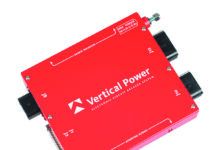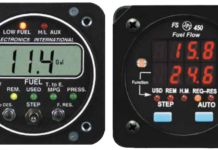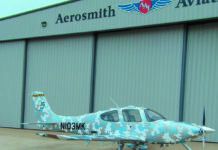In the imaginary world of ideal airplane design, wings would be infinite of length and short of chord, yielding lots of lift and little drag. In the real world of airplane design, that’s not an option, so we resort to aerodynamic tricks to whittle away drag. One of these is winglets, a retrofit idea being aggressively pursued by Tamarack Aerospace.
Although winglets may appear as stylish cosmetics implying speed and modernity, Tamarack claims they’re a lot more practical than that. Winglets mimic the characteristics of a high-aspect-ratio, low-drag wing, so on high-performance aircraft, they increase climb rate and improve efficiency by allowing equivalent cruise speeds at lower power settings.
But it’s not as simple as that, at least for the retrofit market. Even as they add lift, winglets impose additional structural loads on the wing that can exceed its certification limits. Tamarack’s solution? Make the winglet active and capable of dumping the lift in flight regimes where the wing would otherwise be overloaded. Tamarack has been developing its active winglets for several years and made an appearance last fall at AOPA Summit with the system installed on a Cirrus SR22.
While you can buy active winglets for the SR22 ($59,649), Tamarack’s Nick Guida told us that the core market for this product is high-performance aircraft flying at high altitudes, meaning jets and turboprops. Tamarack, which also sells throttle and baggage compartment mods for the Cirrus airplanes, used that model primarily as a certification entré to lay down an approval path for aircraft like the Citation line, which it’s now flying as a test bed.
We flew the company’s winglet-equipped CJ last fall and while we couldn’t collect comparative data with a stock aircraft, we did see the winglets in action. And we do mean action.
The Theory
Fixed winglets improve performance by mimicking a higher-aspect ratio wing. Although they add some parasitic drag, they more than make up for it by reducing induced drag. But there’s no free lunch. Besides the weight of the winglets themselves, the wings also require enough structure to support the load of the additional lift. That adds more weight and is a tradeoff against the improved performance and efficiency. For the would-be retrofitter of winglets, it also presents a potential non-starter. Yes, the winglets add impressive efficiency, but the weight, cost and complexity of the required additional structure may make a net gain elusive in cost if not efficiency.
Tamarack’s solution is to make the winglets—or at least the effect of the winglets and a longer wing—active through a network of sensors that constantly monitor wing loading in all phases of flight. When loading is approaching design limits for the wing structure, a small flap—a spoiler, really—instantly deploys, dumping the lift and relieving the wing structure of any potential overload. In flight, the spoiler activates so quickly that it’s sometimes difficult to see it. (See the accompanying video demonstration.)
In the Tamarack installation on the Citation, the wings get an additional five feet of total length, with the winglet attached outboard of that. The spoiler system—which Tamarack calls ATLAS for Active Technology Load Alleviation System—is on the trailing edge of the added section of wing.
It’s activated by fast-acting electric actuators, which are in turn controlled by an onboard computer system capable of calculating load factors quickly enough to react to turbulence bumps and rapid maneuvering in real time. In the event of system failures or faults, potential winglet overloading is rendered inert by speed envelope limits.
As mods go, this isn’t a cheap one. At $196,000 for the CJ, it can amount to up to 40 percent of the value of an early Citation I, but obviously less for newer models, where it’s more likely to be installed. What does it deliver? Tamarack’s Guida says the winglets are transformational for jets designed during an era when fuel prices weren’t a concern and neither was long range.
“The flight test results we are getting are just extremely impressive,” says Guida. “We are talking about way more than an additional hour of range. As compared to book, we are seeing between 8 and 10 percent improvement in specific fuel consumption,” he adds.
Much of the efficiency comes from getting to altitude quickly because of a higher climb rate, according to Guida. “We get to 410 at gross with a little under 600 pounds of fuel. In the stock airplane, you get can’t get to 410 in the first hour, without burning off fuel. It’s not even in the book,” he says. At 30,000 feet, the modified airplane at gross weight is still climbing at 1500 FPM, says Guida, compared to 200 FPM for the stock airplane.
Flying It
Along with Tamarack’s pilot Brian Willett, we flew the company’s test aircraft on a turbulent day in Florida last fall. Although we couldn’t confirm its performance numbers at high altitude, we did see the ATLAS system perform in turbulence and in 1G-plus maneuvering. On takeoff, the airplane behaves normally, but on climb out, we could see the winglet spoilers activating and de-activating in response to turbulence loading.
They respond quickly enough in some circumstances to be almost invisible. At altitude, we tried some mild-G maneuvering to see how the spoilers deployed and noted that they act more slowly and predictably. Willett told us roll control is comparable to the stock airplane, despite the longer wings. With no basis of comparison, we’ll take his word for it until another Citation pilot who has flown both airplanes tells us otherwise.
For the right CJ operator who needs additional range or payload over shorter range, Tamarack’s winglets may pencil out to make economic sense. We doubt if they make as much sense for a Cirrus owner, since the benefits of winglets accrue at higher altitudes and speeds and a $59,000 upgrade is a large piece of change for limited performance improvement.
For more on Tamarack’s active winglets, contact the company at www.tamarackaerospace.com or 208-255-4400.




